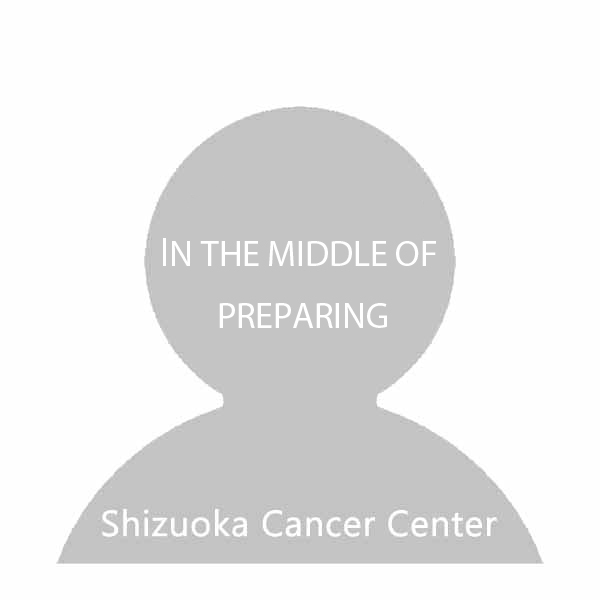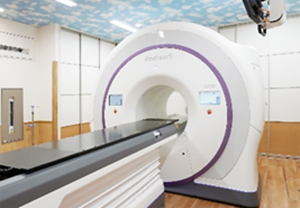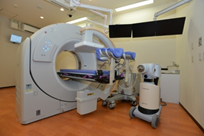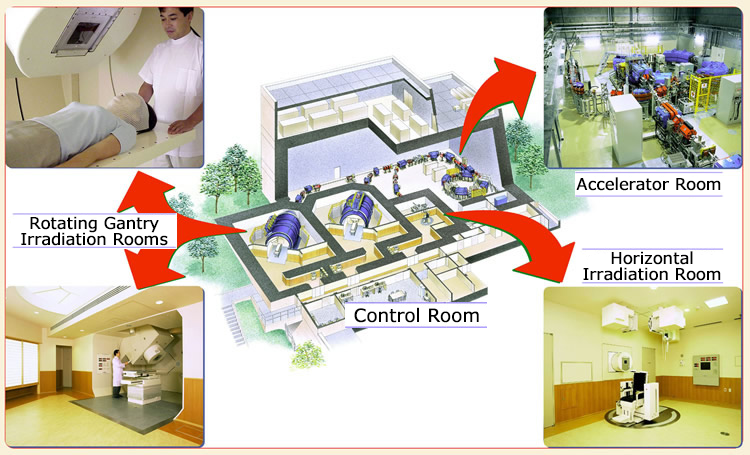 |
 |
 |
 |
 |
| Adviser and Manager, Radiation and Proton Therapy Center Tetsuo Nishimura, M.D., Ph.D. | Chief, Division of Proton Therapy Shigeyuki Murayama, M.D., Ph.D. |
Chief, Division of Brachytherapy Hirofumi Asakura, M.D., Ph.D. |
Chief, Division of Radiation Therapy Hideyuki Harada, M.D., Ph.D. |
Senior Staff Hirofumi Ogawa, M.D. |
 |
 |
 |
 |
 |
| Senior Staff Tsuyoshi Onoe, M.D., Ph.D. |
Senior Staff Minoru Inoue, M.D., Ph.D. |
Senior Staff Kazuaki Yasui, M.D., Ph.D. |
Sayo Maki, M.D. |
Resident Rintaro Yamashita, M.D. |
 |
||||
|
Resident |
At the Radiation and Proton Therapy Center (RPTC), we provide a variety of radiation therapies including external radiotherapy (linac radiation therapy), proton beam therapy and sealed brachytherapy with broad applicability for both curative or palliative intents for the patients with malignant tumors in the entire body.
Radiation therapy (RT) can be featured as minimally invasive for cancer patients. Therefore, for early-staged cancers, the organs and the functions can be well-preserved and quality of life can be retained quite well. For advanced cancers, RT is often provided in conjunction with surgery and/or anti-cancer drug therapy. RT is also applicable for patients who have difficulty taking surgery and anti-cancer drug therapy, including aged patients, which makes the number of patients taking RT quite large. The patients newly starting RT count over 1,400 a year, and the total number of the patients taking RT including those resuming the therapy is over 1,900 a year. These numbers prove that the RPTC is one of the leading RT facilities in Japan.
In order to accommodate ever-growing demands, the doctors at the RPTC constantly work together with all the other doctors at the relevant clinical divisions through joint medical conferences, and tackle the diseases in multidisciplinary teams involving clinical radiation technologists, nurses and medical physicists. We provide each patient and his/her family with a detailed explanation about the therapy until they understand and feel contented about it. At the same time, the patient’s condition is carefully observed daily when he/she receives the therapy, and whenever there is even the slightest change admitted, it will soon be taken care of.
For proton therapy, intensity-modulated radiation therapy (IMRT) and stereotactic irradiation, all of which need to be done with high precisions, highly safe and precise therapies are ensured through collaborations in multidisciplinary team approach and full performances of the cutting-edge systems, because human resources and facility performance are both quite well-consolidated for doing so.
At the Radiation and Proton Therapy Center, the following treatments are being provided.
1) Proton beam therapy
2) External radiation therapy with 4 linac radiation systems
3) Brachytherapy with sealed Ir-192 as radiation source for gynecological and pulmonary cancers
4) Brachytherapy with permanent insertion of sealed I-125 for prostate gland cancer
These radiation therapies are often combined depending on the disease conditions, including combined application of linac radiation and proton beam, in pursuit of the best radiation treatment for cancer.
Also provided is the internally-administered radioisotope therapy in collaboration with the Nuclear Medicine Section.
Proton therapy aiming for complete cure of the following diseases is covered by the Japanese public health insurances (as of April, 2020).
① Pediatric tumors (limited to localized solid malignancy)
② Soft tissue tumor (i.e., chordoma, chondrosarcoma and osteosarcoma which are difficult to be cured completely by surgery but are remaining localized)
③ Malignant tumor in the head and neck region (i.e., nasal and paranasal sinus squamous cell carcinoma, malignant melanoma in the head and neck region, olfactory neuroblastoma and adenoid cystic cancer, excluding squamous cell cancer in mouth or laryngopharynx)
④ Prostate gland cancer (limited to localized and locally progressed prostate gland cancer without metastasis)
Proton therapy for any diseases or conditions other than the above-mentioned, it will be provided in the category of “advanced medicine.” The applicable diseases and the irradiation methods for such cases will be strictly in accordance with the standardized therapeutic strategy established among the aligned proton therapy facilities nationwide.
As for the linac radiation therapy, the new model dedicated to high-precision radiation therapy (Radixact X9) was installed in October, 2020. With this newly-installed system which accounts for the fourth one, the RPTC is now even more fully equipped than ever. Radixact X9 features so-called “zeroing-in-on function,” with which it can keep on tracking the tumor in the lung, for instance, targeting the tumor in synchronization with the respiratory displacement at all times during the dose delivery. It is expected to boost up the favorable outcomes from RT further.

The Linac Radiation System is for delivering powerful radiation (i.e., X-ray and electron beam) externally towards the tumor mass. There are 4 units at the SCC. The dose and the irradiation method are discussed at the multidisciplinary joint conference for each patient, and the therapy is always provided in safe and precise manner. We are accommodated for image-guided radiation therapy (IGRT) which enables us to focus on precision of irradiation with image collation, and intensity modulated radiation therapy (IMRT) which provides us with 3-dimensional radiation dose distribution best suited for precise configuration of tumor.
|
Therapy |
Model (Manufacturer) |
X-ray Energy |
Special Functions and Applicable |
|
1 |
TrueBeam (Varian) |
4/6/8/10/15 MV |
IMRT, IGRT |
|
2 |
TrueBeam (Varian) |
4/6/8/10/15 MV |
IMRT, IGRT |
|
3 |
TrueBeam STx (Varian) |
4/6/8/10 MV |
MRT, IGRT, total-body irradiation, stereotactic irradiation |
|
4 |
Radixact (Accuray) |
6 MV |
IMRT, IGRT, tumor tracking irradiation |

This is a therapy system with a small radiation source induced in the tumor mass neighborhood. Brachytherapy with a sealed high-dose-rate (HDR) radiation source with Ir-192 is mainly provided for gynecological cancer (cancer in uterine cervix or uterine body), either by itself or in combination with external radiation therapy on the linac radiation system.
Not limited to gynecological cancer, it can also be applied to lung cancer. In February, 2015, a computed tomography (CT) system was newly installed in the therapy room. The CT images have created more desirable clinical environment for image-guided brachytherapy (IGBT) since then, as they let us make more precise therapeutic plans than ever.
For prostate gland cancer, brachytherapy, with a small sealed radiation source of I-125 inserted and placed permanently in prostate gland, is provided. For this therapy, a patient is anesthetized locally from the waist down, and from 50 to 80 small low-dose-rate radiation sources with I-125 are inserted into his prostate gland through the perineal region and they are placed there on a permanent basis. At the SCC, the patient needs to stay in the hospital only for three days including the day for the procedure
|
Therapy Method |
System Model |
CT Model |
|
HDR-brachytherapy |
Micro-selectron HDR (irradiation system) |
Aquilion PRIME |
|
Oncentra Brachy (therapeutic planning system) |
||
|
Permanent insertion of sealed brachytherapy source |
Oncentra Seed (therapeutic planning system) |
The system and the facility for proton therapy consist of the Accelerator Room, the Rotating Gantry Irradiation Rooms (2), the Horizontal Irradiation Room, and the Control Room.

brachytherapy
gynecology, ophthalmology and dermatology terrains
radiation therapy in general
Certified Radiologist and Radiation Therapy Specialist. Supervisory Doctor for Training, the Japan Radiological Society
Radiation Therapy Specialist Certified by the Japan Society for Radiation Oncology
General Clinical Oncologist Certified by the Japanese Board of Cancer Therapy
The Japan Society of Clinical Oncology
The Japan Society of Gynecologic Oncology
cancer treatment with proton beam
pediatric, hepatic and urological terrains
radiation therapy in general
Certified Radiologist and Radiation Therapy Specialist, Supervisory Doctor for Training, the Japan Radiological Society
Certified Radiation Therapy Specialist and Representative, the Japan Society for Radiation Oncology
General Clinical Oncologist Certified by the Japanese Board of Cancer Therapy
The Japan Society of Clinical Oncology
The Japan Society for Head and Neck Cancer
The Japanese Clinical Study Group of Particle Therapy (JCPT)
brachytherapy
urology and gynecology terrains
radiation therapy in general
Certified Radiologist, Radiation Therapy Specialist and Supervisory Doctor for Training, the Japan Radiological Society
Certified Radiation Therapy Specialist, Representative, the Japan Society for Radiation Oncology
General Clinical Oncologist Certified by the Japanese Board of Cancer Therapy
The Japan Society of Clinical Oncology
The American Society for Therapeutic Radiology and Oncology (ASTRO)
high-precision radiation therapy
respiratory, brain and osseous soft tissue terrains
radiation therapy in general
Certified Radiologist, Radiation Therapy Specialist and Supervisory Doctor for Training, the Japan Radiological Society
Certified Radiation Therapy Specialist, Representative, the Japan Society for Radiation Oncology
General Clinical Oncologist Certified by the Japanese Board of Cancer Therapy
The Japan Lung Cancer Society
The Japan Society of Clinical Oncology
The Japanese Clinical Study Group of Particle Therapy (JCPT)
The American Society for Therapeutic Radiology and Oncology (ASTRO)
IMRT
head and neck, and esophagus terrains
radiation therapy in general
Certified Radiologist, Radiation Therapy Specialist and Supervisory Doctor for Training, the Japan Radiological Society
Radiation Therapy Specialist Certified by the Japan Society for Radiation Oncology
The Japan Society of Clinical Oncology
The Japan Society for Head and Neck Cancer
osseous soft tissue terrain
mammary gland terrain
radiation therapy in general
Certified Radiologist, Radiation Therapy Specialist and Supervisory Doctor for Training, the Japan Radiological Society
Radiation Therapy Specialist Certified by the Japan Society for Radiation Oncology
Certified Physician, the Japanese Society of Internal Medicine
radiation therapy in general
Certified Radiologist, Radiation Therapy Specialist and Supervisory Doctor for Training, the Japan Radiological Society
Radiation Therapy Specialist Certified by the Japan Society for Radiation Oncology
The Japanese Cancer Association
The Japan Society of Clinical Oncology
respiratory, brain and osseous soft tissue terrains
urinary organs and gynecology terrains
radiation therapy in general
Certified Radiologist and Radiation Therapy Specialist, the Japan Radiological Society
Radiation Therapy Specialist Certified by the Japan Society for Radiation Oncology
radiation therapy in general
Certified Radiologist. Radiation Therapy Specialist and Supervisory Doctor for Training, the Japan Radiological Society
Radiation Therapy Specialist Certified by the Japan Society for Radiation Oncology
The Japan Radiological Society
The Japan Society for Radiation Oncology
The Japan Radiological Society
The Japan Society for Radiation Oncology